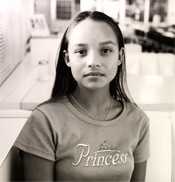 |
||||
| Still from What a Girl Wants (Creator/Producer Elizabeth Massie, 2001). Used with permission from Media Education Foundation. | ||||
|
||||
Journal Issue 3.1
Spring 2011
Edited by Agatha Beins, Deanna Utroske, Julie Ann Salthouse, Jillian Hernandez, and
Karen Alexander
Editorial Assistants: Mimi Zander and A.J. Barks
I Was A Teenage Feminist: A Documentary about Redefining the F-word. Directed by Therese Shechter. New York: Women Make Movies, 2005.
What a Girl Wants. Directed by Elizabeth Massie, Jacob Bricca, and Matthew Buzzell. Northampton, MA: Media Education Foundation, 2001.
Reviewed by Ilana Nash
As a result of the backlash against feminism in the mainstream media, young women today are inundated with mediated messages that damage their self-esteem and deny them access to the self-empowering ideals of feminism. I Was A Teenage Feminist (62 min.) addresses this issue through the autobiographical journey of Therese Shechter, who struggles to reconnect with the feminism she enjoyed in her 1970s youth; What A Girl Wants (33 min.) explores the issue from a different angle, interviewing kids and teens about their reactions to the portrayals of girls in the media. While Shechter’s film is a thoughtful rumination on the definition(s) of feminism in contemporary culture, What A Girl Wants is a simple indictment of the images of girls in teen media, and these images’ impact on young consumers.
“What does it mean to be a feminist today?” asks Therese Shechter. During her youth in the 1970s, feminism was “all around” and gave her a sense of power. Now, as a single woman on the cusp of turning forty, she feels “incredible pressure to conform to an ideal I don’t even buy into,” and wonders, “What happened to my feminism and the power it gave me?” In seeking the answer, Shechter reveals the importance of media. Her own feminism was ignited in 1974 by the Emmy-winning television special, Free to Be…You and Me, “the first feminist media especially for us kids.” But in her interview with Letty Cottin Pogrebin, a founding editor of Ms. magazine and a consultant on Free to Be…You and Me, Shechter mourns: “These people lied to me. . . .They promised me that everything would be OK, and it’s not.” Pogrebin sympathizes, but delivers a bracing response: “All we said was, let’s get rid of the barriers and let’s open up doors. We didn’t promise you a rose garden. . . .I’m sixty-two now. It’s your turn.”
Calling this “the kindest kick in the ass that I’ve ever gotten,” Shechter sets out to problematize feminism’s seeming disappearance, demonstrating that reports of its death have been greatly exaggerated. She interviews a media analyst who tells us that mainstream media have pronounced feminism “dead” since its inception. This negative publicity has persuaded people to disavow “the F-word.” Shechter’s interview subjects, however, prove that feminist ideas still thrive: we see the young singer who thinks feminism is passé, but who leaves her boyfriend when she feels constrained by her passive role; the music producer who organizes women’s music festivals; and the editors of Bust magazine, to name a few. Concluding her film at the 2004 March for Women’s Lives in Washington, D.C., Shechter proves that feminism is still available to anyone willing to look past the media’s dismissals. This film might serve well in a college class on the history of feminism in public discourse.
A little feminist consciousness would be useful in teen media, which is lambasted for its obsession with “perfect” appearances in What A Girl Wants, produced by the Media Education Foundation. At only 30 minutes it’s well suited to a teenage classroom. Its interview subjects (mostly girls, between the ages of eight and sixteen) offer their opinions on the media’s definitions of beauty, and the sexualization of teen-girl icons like Britney Spears (made in 2001, the film is dated now).
Many interviewees complain that skinny, flawless models promote poor self-esteem, and note that the sexualized content of teen media pressures kids to become sexually active “too young.” It’s hard to find the feminism in some of this; at times, the film’s message is indistinguishable from right-wing complaints about the supposed evils of teen sex. Still, viewers will cringe when they learn that a maker of pornography films directed Britney Spears’s and Mandy Moore’s music videos, or when they see a thirteen-year-old girl who prides herself on her knowledge of makeup techniques to hide her meticulously catalogued “flaws.”
The film’s point, conveyed in an alarmist, preachy manner, is something of a cliché now; but for tweens and teens who have never heard (anything good) about feminism, What a Girl Wants might help them recognize media’s impact on young people’s views of girlhood, and to adopt some healthy skepticism when assessing mediated messages.
Ilana Nash is an associate professor of English and Gender & Women’s Studies at Western Michigan University. She is the author of American Sweethearts: Teenage Girls in Twentieth-Century Popular Culture (2006), and “The Innocent Is a Broad: Teenage Virgins in Global Contexts,” in Virgin Territory: Representing Sexual Innocence in Film, ed. Tamar Jeffers McDonald (2010). She serves on the advisory board of Girl Museum, and is the owner of the Girls’ Studies Scholars online discussion list.
Copyright © 2014. All rights reserved.